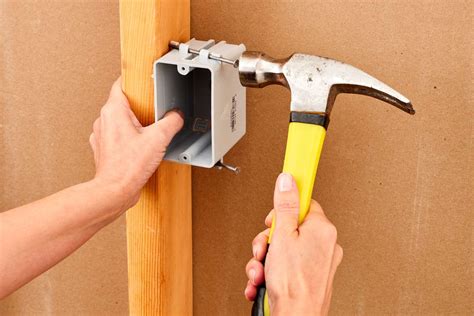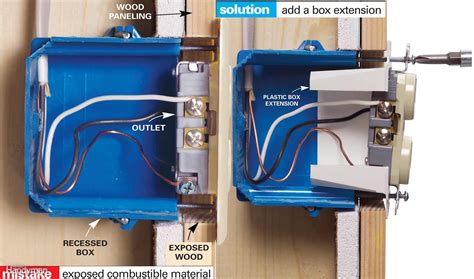can i put a junction box in a wall Yes, it is possible to put an electrical junction box in the wall. The process involves cutting an appropriate size hole in the wall to mount the junction box, running the necessary wiring to the .
Use an arc welder to weld galvanized steel. A standard arc welder is undoubtedly the best way to weld galvanized steel. Arc welding is a versatile method that uses alternating currents to create a high-heat arc that melts your flux. If .
0 · putting electrical box existing drywall
1 · installing wall mounted electrical boxes
2 · installing electrical box on drywall
3 · home electrical junction box install
4 · electrical junction box installation instructions
5 · electrical box installation instructions
6 · adding electrical box to existing
7 · adding electrical box existing wall
The best welders for sheet metal is a MIG or TIG welder due to their precision and control. Key specifications include a wide amperage range for better control, a high duty cycle for longer welding sessions, and a stable arc for clean, high-quality welds.
It is a safety hazard to completely bury a junction box in a wall. A junction box, also known as a splice or switch box, is an electrical enclosure inside your . Installing a Junction Box in a Wall: A Step-by-Step Guide • Junction Box Installation • Learn how to safely and effectively install a junction box in a wall,. Considering the NEC guidelines, it is generally not recommended to place a junction box inside a wall. This is primarily because accessibility can be compromised if the . The box should be mounted securely to a stud or joist, with its face flush to the wall surface. For exterior installations, select a location that provides protection from direct exposure to the elements.
It is possible to put a junction box behind a wall yet highly recommended not to do so as it violates the building code and standards. Putting junction boxes behind the walls makes it difficult to access and a safety risk.Yes, it is possible to put an electrical junction box in the wall. The process involves cutting an appropriate size hole in the wall to mount the junction box, running the necessary wiring to the .
Follow these expert tips to install an electrical box into drywall or plaster without the need for wall studs or joists. Not all fixtures need to be attached to a wall stud or joist. Lightweight fixtures can hold up on plaster or . Learn how to install an electrical junction box, why you might need one, and how to safely install it. What Is a Junction Box? A junction box is a standard electrical box that contains two or more spliced electrical cables. The .

Mounting the Junction Box. Choose an appropriate location for the junction box, making sure it’s easily accessible. Securely mount the box to the wall or ceiling using appropriate screws. Ensure that it’s flush and level for a .It is a safety hazard to completely bury a junction box in a wall. A junction box, also known as a splice or switch box, is an electrical enclosure inside your home that contains wiring. Electrical wires run behind the walls and through the ceiling of your home, meeting at junction boxes.Installing a Junction Box in a Wall: A Step-by-Step Guide • Junction Box Installation • Learn how to safely and effectively install a junction box in a wall,.
Considering the NEC guidelines, it is generally not recommended to place a junction box inside a wall. This is primarily because accessibility can be compromised if the junction box is hidden within the wall cavity. Mount the junction box on the wall. Always use the designated holes or brackets on the junction box to secure it to the wall. Many junction boxes come packaged with the proper fasteners. They can be screwed onto wall studs or ceiling joists. You may also attach them to adjustable brackets placed between studs or joists. The box should be mounted securely to a stud or joist, with its face flush to the wall surface. For exterior installations, select a location that provides protection from direct exposure to the elements.
It is possible to put a junction box behind a wall yet highly recommended not to do so as it violates the building code and standards. Putting junction boxes behind the walls makes it difficult to access and a safety risk.Yes, it is possible to put an electrical junction box in the wall. The process involves cutting an appropriate size hole in the wall to mount the junction box, running the necessary wiring to the box, connecting the wiring to the box as needed, and then putting the device cover on the box.

Follow these expert tips to install an electrical box into drywall or plaster without the need for wall studs or joists. Not all fixtures need to be attached to a wall stud or joist. Lightweight fixtures can hold up on plaster or drywall if you have a remodel electrical box.
Learn how to install an electrical junction box, why you might need one, and how to safely install it. What Is a Junction Box? A junction box is a standard electrical box that contains two or more spliced electrical cables. The box must have a removable, accessible cover. Junction boxes can be placed along electrical conduit, too. Mounting the Junction Box. Choose an appropriate location for the junction box, making sure it’s easily accessible. Securely mount the box to the wall or ceiling using appropriate screws. Ensure that it’s flush and level for a neat and professional appearance. Connecting Wires Inside the Junction BoxIt is a safety hazard to completely bury a junction box in a wall. A junction box, also known as a splice or switch box, is an electrical enclosure inside your home that contains wiring. Electrical wires run behind the walls and through the ceiling of your home, meeting at junction boxes.
putting electrical box existing drywall
Installing a Junction Box in a Wall: A Step-by-Step Guide • Junction Box Installation • Learn how to safely and effectively install a junction box in a wall,.
Considering the NEC guidelines, it is generally not recommended to place a junction box inside a wall. This is primarily because accessibility can be compromised if the junction box is hidden within the wall cavity. Mount the junction box on the wall. Always use the designated holes or brackets on the junction box to secure it to the wall. Many junction boxes come packaged with the proper fasteners. They can be screwed onto wall studs or ceiling joists. You may also attach them to adjustable brackets placed between studs or joists. The box should be mounted securely to a stud or joist, with its face flush to the wall surface. For exterior installations, select a location that provides protection from direct exposure to the elements.
It is possible to put a junction box behind a wall yet highly recommended not to do so as it violates the building code and standards. Putting junction boxes behind the walls makes it difficult to access and a safety risk.
Yes, it is possible to put an electrical junction box in the wall. The process involves cutting an appropriate size hole in the wall to mount the junction box, running the necessary wiring to the box, connecting the wiring to the box as needed, and then putting the device cover on the box. Follow these expert tips to install an electrical box into drywall or plaster without the need for wall studs or joists. Not all fixtures need to be attached to a wall stud or joist. Lightweight fixtures can hold up on plaster or drywall if you have a remodel electrical box. Learn how to install an electrical junction box, why you might need one, and how to safely install it. What Is a Junction Box? A junction box is a standard electrical box that contains two or more spliced electrical cables. The box must have a removable, accessible cover. Junction boxes can be placed along electrical conduit, too.
installing wall mounted electrical boxes

Go to a welding supplier, like an AIRGAS, get some ER70s-6 TIG rod, probably 3/32" or 1/8" and TIG away. Prep work is the key to a good job - take it down to new metal, and when you're done repaint it for corrosion protection.
can i put a junction box in a wall|putting electrical box existing drywall